
table of contents
- Perennials for partial shade
- Perennials that stay small and cover the ground
- From A - E
- From I - V
- Medium high species
- From B - H
- From S - T
- Tall, hardy penumbra perennials
- From A - G
- From H - R
Perennials are perennial, hardy and easy to care for plants and the basis of a beautiful garden. The range of flowering, ground covering or ornamental perennials for partial shade is extremely diverse. There is something for every taste, garden style, soil and every location. They can stand in the same place for many years. Correctly placed, they come into their own in individual and group positions or as a hedge and background plant and can be combined in many ways.
Perennials for partial shade
When it comes to garden design, hardy perennials are usually always the first choice. But not all perennials are the same, because each has its own requirements, especially when it comes to the right location. Accordingly, perennials do not tolerate partial shade direct sun nor permanent sun exposure
. They prefer shaded areas with short-term but regular sun exposure. Partially shaded locations are shaded about half of the day. The sun only shines here in the morning or in the evening. Once the best place has been found, the next step is to select the plants.Perennials that stay small and cover the ground
From A - E
Runners-forming Waldsteinia (Waldsteinia ternata)
These plants develop beautiful carpets of bright yellow, bowl-shaped flowers from runners from April to June. They form a great contrast to the fresh green foliage. They grow up to 15 cm high and are particularly effective in small or large groups.
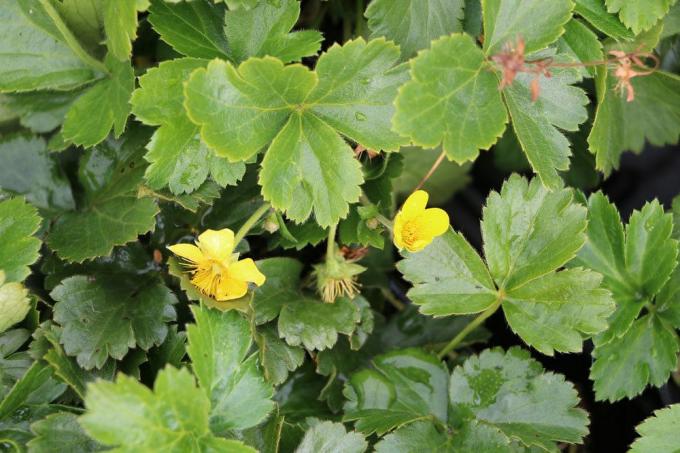
Balkan cranesbill 'Spessart' (Geranium macrorrhizum)
With its extravagant pink-colored buds and whitish flowers, the Balkan cork's bill adorns beds and borders from May to July. The strong green and strongly fragrant foliage turns yellowish to reddish in autumn. The height is around 30 cm.
tip: Geranium macrorrhizum is best planted in groups of three to seven. This is how they can best develop their effect.

Blue-and-gold hosta 'June' (Hosta tardiana)
Hostas are decorative foliage plants whose greatest ornament is the intense color of their large leaves. A particularly splendid specimen is the blue-gold funkie, which is only 20-25 cm tall. The powdery, frosted, blue-greenish-gold-colored leaves with an irregular blue-green edge are a real eye-catcher in early summer. From July to August, pale purple to white, racemose panicles on upright stems are enthroned above the leaves.
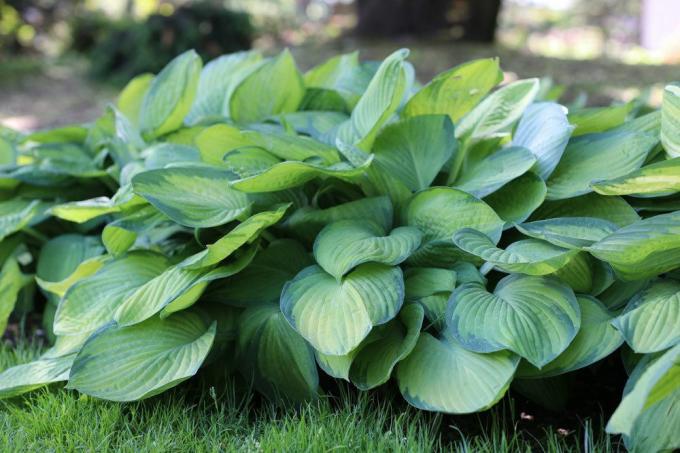
Chinese leadwort (Ceratostigma plumbaginoides)
The lead root, which is up to 25 cm high, flowers relatively late. From August to October it is adorned with a bright, gentian-blue flower pile. This late summer shrub is hardy, very easy to spread and quickly forms colorful cushions. The gray-green of the leaves turns reddish in autumn.

Elven flower 'Frohnleiten' (Epimedium perralchicum)
- Elven flower 'Frohnleiten', a very vigorous ornamental leaf
- Flat ground cover up to 40 cm high
- Is characterized by its colorful foliage
- Leaves drawn brownish-green
- Brown-red color in autumn
- Flowering time from April to May
- Flowers small, delicate, sulfur yellow

From I - V
Periwinkle 'Alba' (Vinca minor)
The evergreen is generally hardy, very versatile and undemanding, as is the 'Alba' variety. The carpet-forming dwarf shrub has dense, dark green foliage and bright white flowers from May to September. These ground-covering, hardy perennials reach heights of growth of up to 20 cm.

tip: The white flowering evergreen can be combined very well with the blue flowering evergreen.
Lung Herbs (Pulmonaria)
Lung herbs usually bloom from March to April. Its delicate flowers, arranged in coiled clusters, can be red, purple, blue or white. The leaves are also very decorative, the shape of which varies depending on the species. They are completely green, spotted white or have a silver-gray surface. Lung herbs rarely grow taller than 20-30 cm.
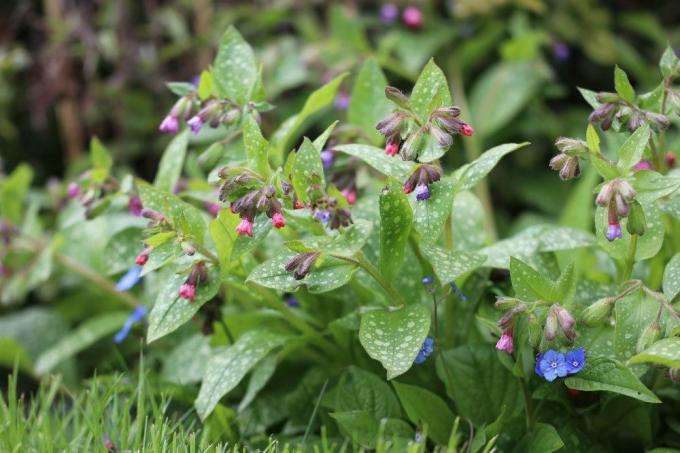
Moss saxifrage 'carpet of flowers' (Saxifraga arendsii)
This cushion-forming rock garden shrub, up to 15 cm in size, is particularly noticeable from April to May with its chalice-shaped, carmine-pink flowers. Its leaves form rosettes from which evergreen cushions develop, which are covered by the colorful flowers in spring.

Rose Woodruff (Phuopsis stylosa)
Characteristic of the Rosenwaldmeister are long, prostrate shoots with which he forms dense carpets. During flowering, from June to August, this vigorous, up to 20 cm high ground cover shows its spherical or spherical shape. Radiant, pink and intensely fragrant flower balls.

Velvet-haired silver bells 'Berry Smoothie' (R) (Heuchera villosa)
With beautifully colored foliage, this silver bell presents itself in partial shade. Its pink-red, rounded and slightly wavy leaves make it a popular ornamental leaf. These 20-50 cm tall plants produce white, panicle-shaped flowers from June to August.
Forget-Me-Not (Myosotis)
- Forget-me-not blooms blue in its original form
- Now also available with white and pink-blue flowers
- Can sometimes even be two or more colored
- Flowers are long-stalked panicles
- Consists of many small individual flowers
- Leaf color varies between a rich and dark green
- Spring bloomers reach heights of 20-40 cm
- Is particularly effective in larger groups.

Medium high species
From B - H
Blue monkshood (aconitum napellus)
The monkshood is one of the most attractive plants in the garden. On their stiff, upright, leafy and 120-160 cm high stems, the deep purple-blue, helmet-like flowers sit from June to August. They are four to five centimeters tall and stand in long, dense clusters.

tip: As beautiful as the blue monkshood is, it is one of the most poisonous plants in our latitudes.
Garden umbel bellflower 'Prichard' (Campanula lactiflora)
From June to August this umbelliferous bellflower forms small, violet-blue, bell-shaped and pleasantly scented flowers in huge numbers. Its leaves are medium and summer green. It reaches heights of growth of around 80 cm.

tip: We recommend a small support and a complete cut back after flowering.
Autumn anemone 'Honorine Jobert' (Anemone x japonica)
The autumn anemone 'Honorine Jobert' combines timeless elegance with classic beauty. Because with its half-double, pure white flowers and the clearly defined yellow stamens, it is the star in autumn discounts and in partial shade. The contrasting flowers sit on very filigree, blue-gray leafed stems. The height is 80 cm.

tip: Frost protection and sun protection is recommended when it is cold.
From S - T
Slender fuchsia (Fuchsia magellanica var. Gracilis)
- Fuchsia has a slim, densely bushy and graceful growth
- The bell-shaped flowers are the greatest ornament
- They are noticeable for their purple-purple color
- The long, protruding stamens are also noticeable
- Stems are slightly reddish in color
- Grow up to 80 cm long
- Flowering time lasts from July to September
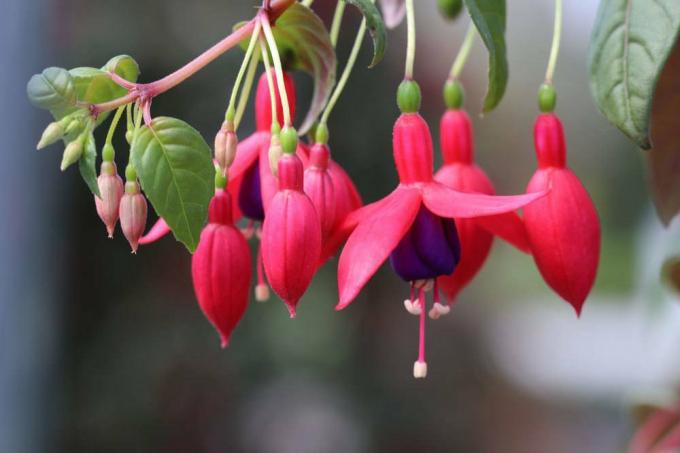
Shrub peony 'Pink Beauty' (Paeonia rockii 'Fen Xi Shi')
In May and June this 120 cm high shrub peony presents its full splendor, the large, half-double and slightly ruffled flowers. They show a color gradient from pure white to a delicate pink with dark purple basalt stains inside. They also give off a pleasant scent.
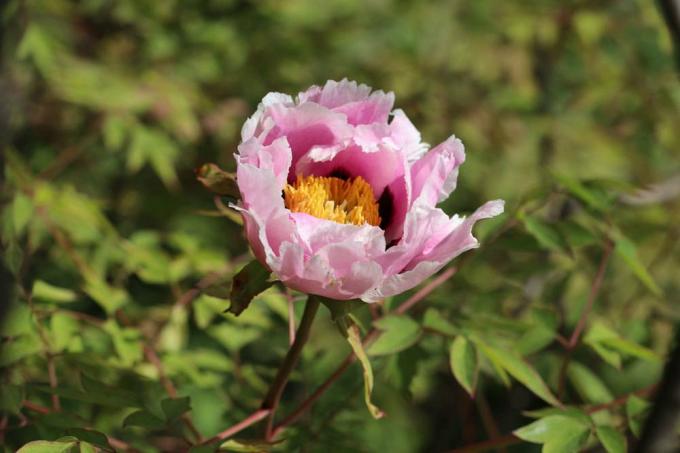
Tafelblatt (Astilboides tabularis)
- Tafelblatt is hardy and up to 100 cm high
- Leaves are huge and extremely decorative
- Can reach diameters of up to 90 cm
- Are rough, hairy, and notched on the edge
- Tafelblatt takes up a lot of space
- The comparatively small, greenish-white flowers appear in June
- They are arranged in panicles
Bleeding heart (lamprocapnos spectabilis)
From May onwards, the strikingly heart-shaped, white to pink-red flowers with white, drop-shaped appendages sit close together on long, arching overhanging shoots. The green, two- to three-pinnate leaves are also very decorative. The watery heart is completely hardy and is 60-80 cm high.
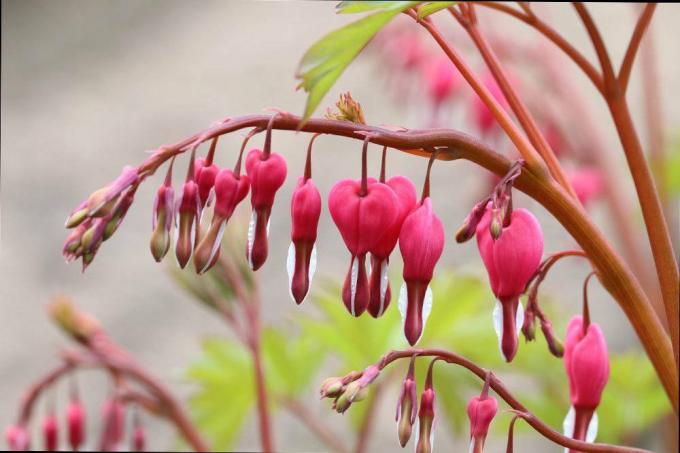
Tall, hardy penumbra perennials
From A - G
Akeleiblättrige meadow rue 'Black Stockings' (Thalictrum aquilegifolium)
This magnificent meadow rue is a jewel in every garden. It grows upright with black, leafy stems and showy, beautiful, large, purple-pink flower umbels. They adorn the up to 170 cm high plant from July to August.

Garden October silver candle (Cimicifuga simplex)
With its pure white, candle-like flower panicles, this attractive perennial brings the summer to a close. The flowers appear in large numbers from September to October. They make for a magical sight and light up partially shaded areas in the garden. This silver candle is also very hardy and grows up to 130 cm high.
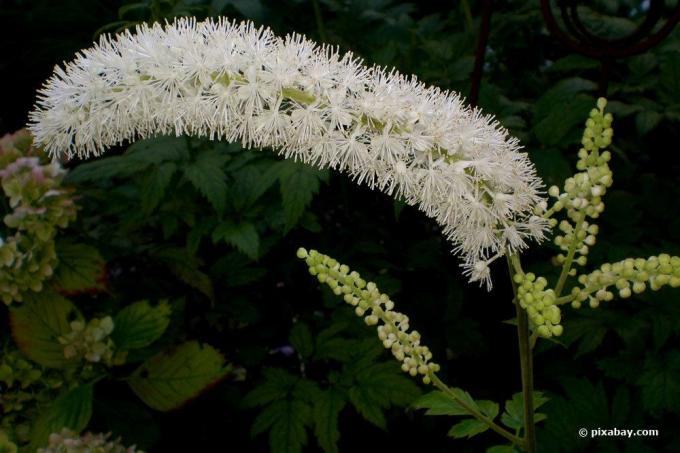
Spice bush 'Hartlage Wine' (Calycanthus raulstonii)
The spice bush is a rather rare flowering shrub. In addition to the glossy green leaves that turn buttery yellow in autumn, it displays its beautiful flowers between May and September. They are carmine red, lightened in cream color towards the middle and delicately scented. This perennial grows up to 300 cm.
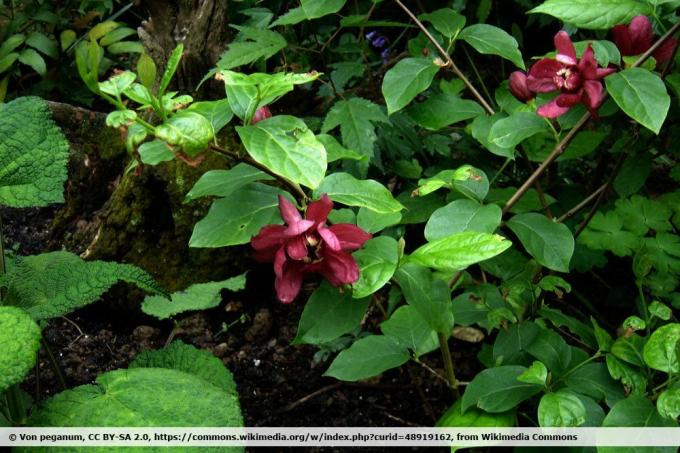
From H - R
High forest goat's beard (Aruncus dioicus)
This plant is valued because of its up to 30 cm long, creamy white flower panicles as well as its double-pinnate, dark green leaves. The broadly spreading perennial is very hardy and can reach heights of up to 200 cm.
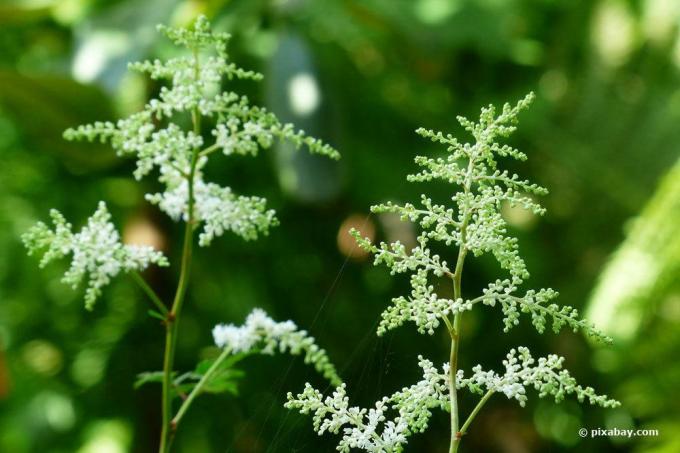
Bay-leaved rockrose (Cistus laurifolius P1)
This richly blooming rock rose, up to 150 cm high, is considered to be hardy in warm regions, provided it is protected from winter sun and heavy frosts. Its numerous white and bowl-shaped flowers then form a beautiful contrast to the winter-green, spicy-tart scented foliage from July to August.
tip: Even if this perennial is hardy, a light winter protection in the form of a cover is recommended.

Panicle hydrangea 'Limelight' -S- (Hydrangea paniculata)
The growth of this panicle hydrangea is stable, upright and bushy. Its flower panicles, up to 30 cm long, gave this plant its name. She then shows them in full splendor from July to September / October. This fast-growing hydrangea reaches sizes of up to 200 cm.

Red angelica (Angelica gigas)
- Red angelica is extremely decorative during flowering
- Flowers are purple, dome-shaped umbels
- They sit on stems that are also purple
- Can reach diameters of up to 15 cm
- The flowering period extends from July to September
- Growth height is up to 200 cm
- In the first year only leaves sprout from a large rosette
- Not until the second year of standing, formation of the purple-red stems and flowers

tip: If they come into contact with the skin, however, the leaves of these plants can cause allergic skin reactions in sensitive people. It is therefore advisable to wear gloves and, above all, long-sleeved clothing when handling her.





